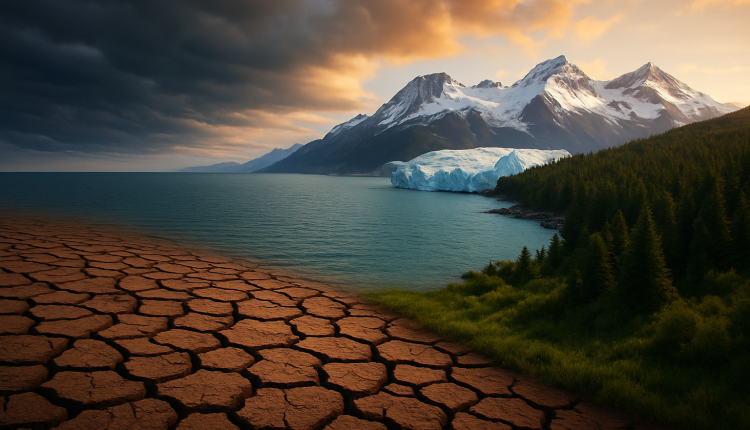- Advertisement -
For decades, scientists have warned about the long-term effects of climate change. Rising global temperatures, melting ice caps, and extreme weather events have become household concerns. But what if we are closer to irreversible climate shifts than we imagined? This article delves into the concept of climate tipping points — critical thresholds in the Earth’s systems that, once crossed, can trigger dramatic and potentially irreversible changes. Understanding these tipping points and how human activity accelerates them is crucial if we are to slow — or even reverse — the trajectory we’re on.
What Are Climate Tipping Points?
Climate tipping points are thresholds where a slight rise in temperature or environmental pressure can lead to large-scale changes in the Earth’s systems. These changes are not gradual — they are sudden and often self-perpetuating. Unlike typical climate variations that follow predictable patterns, tipping points lead to non-linear consequences, making them difficult to reverse once triggered.
Examples include:
- Melting of the Greenland and West Antarctic Ice Sheets
- Collapse of the Amazon Rainforest
- Disruption of Atlantic Meridional Overturning Circulation (AMOC)
- Loss of Arctic sea ice
- Thawing of permafrost releasing methane
1. Melting Ice Sheets and Rising Sea Levels
The Greenland and West Antarctic ice sheets hold enough frozen water to raise global sea levels by over 10 meters if completely melted. Current warming trends are accelerating the disintegration of these ice sheets. Once the melting reaches a certain point, the ice sheet’s own weight and shape make it impossible to stop the process, even if global temperatures stabilize.
Implications:
- Submergence of coastal cities
- Displacement of millions of people
- Increased salinity and disruption of oceanic ecosystems
2. Amazon Rainforest Dieback
The Amazon is often called the “lungs of the Earth,” absorbing vast amounts of CO₂ and producing oxygen. However, deforestation, fires, and prolonged droughts are weakening this vital ecosystem. Scientists warn that if deforestation exceeds 20-25% of the forest area, it could shift from a rainforest to a savannah-like ecosystem, significantly reducing carbon capture.
Implications:
- Increased atmospheric CO₂
- Massive biodiversity loss
- Altered regional and global rainfall patterns
3. Arctic Sea Ice Decline
Arctic sea ice has decreased dramatically in both thickness and extent. This reduction reduces the Earth’s albedo (reflectivity), which means more solar radiation is absorbed by dark ocean waters rather than reflected back into space. This process accelerates warming in a self-reinforcing feedback loop.
Implications:
- Faster global temperature rise
- Altered jet stream patterns
- More extreme and prolonged weather events
4. Thawing Permafrost and Methane Release
Permafrost in the Arctic contains massive amounts of methane — a greenhouse gas more than 80 times more potent than CO₂ over 20 years. As the permafrost thaws, this methane is released, potentially creating a feedback loop of escalating global warming.
Implications:
- Sudden temperature surges
- Further ice melt and sea-level rise
- Accelerated shift toward climate instability
5. Collapse of the Atlantic Ocean Current (AMOC)
The AMOC, part of the Gulf Stream system, helps regulate climate by transporting warm water from the tropics to the North Atlantic. Recent studies suggest this current is weakening — and may be closer to collapsing than previously thought. A shutdown could bring dramatic climate shifts across Europe, North America, and the tropics.
Implications:
- Colder winters in Western Europe
- Stronger hurricanes on the U.S. East Coast
- Monsoon failures in Africa and South Asia
The Interconnected Nature of Tipping Points
Perhaps the most alarming aspect of these climate thresholds is that they do not act in isolation. Crossing one tipping point can accelerate others, creating a cascading domino effect across the planet. For instance, melting ice contributes to ocean warming, which can weaken ocean currents and affect rainfall patterns — potentially pushing rainforests toward collapse.
Are We Too Late?
Recent research from the Potsdam Institute for Climate Impact Research suggests that some tipping points, like Arctic sea ice and coral reef loss, may already be in motion. Others, like AMOC and Amazon rainforest collapse, could be triggered if global warming exceeds 1.5 to 2°C above pre-industrial levels — a threshold we are on track to breach in the next few decades.
What Can Be Done?
While the outlook may seem grim, all is not lost. The key lies in urgent, widespread action.
1. Rapid Emission Reductions
Governments must commit to and exceed their emissions targets under the Paris Agreement. Transitioning to renewable energy, halting deforestation, and improving transportation infrastructure can all drastically reduce CO₂ output.
2. Reforestation and Nature-Based Solutions
Restoring degraded ecosystems, planting trees, and conserving wetlands can help absorb carbon and restore biodiversity.
3. Climate-Resilient Infrastructure
Preparing cities and communities for climate impacts — such as sea-level rise and extreme weather — can mitigate economic and human loss.
4. International Collaboration
Tipping points are a global issue. Addressing them requires a unified, cross-border response involving both industrialized and developing nations.
5. Support for Climate Science
Increased funding for monitoring and predictive climate modeling is essential to stay ahead of these changes and respond effectively.
Final Thoughts
Climate tipping points are not distant possibilities — they are looming threats. Some are already showing signs of instability. The choices we make today will determine whether we nudge the Earth into a new, unpredictable climate era or steer it back from the brink. Humanity still holds the reins, but the window for action is rapidly closing.
Understanding and addressing climate tipping points isn’t just an environmental responsibility — it’s a global survival imperative.

